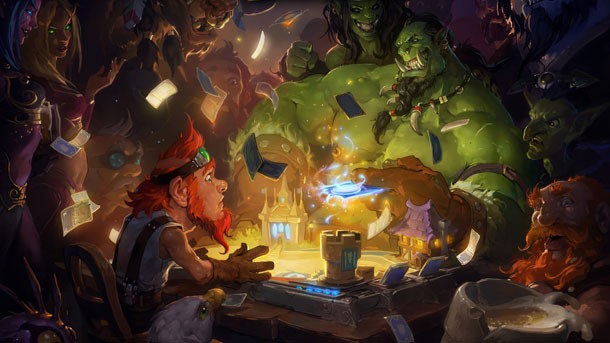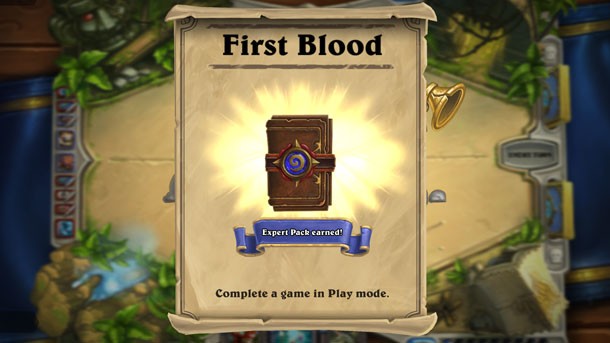Our extra-large special edition is here. Subscribe today and receive the 25% longer issue at no extra cost!
Free-To-Play Done Right: Six Lessons To Learn From Hearthstone

For many gamers, nothing sucks the excitement and promise out of a title like the term "free-to-play." The monetization method has become synonymous with time gates, nagging messages, broken balancing, and other unnecessary burdens designed to maximize profit instead of entertainment. However, the free-to-play format doesn't have to be a cursed albatross; Blizzard's new collectible card game offers players a wealth of enjoyment without asking for a dime. Here are some lessons that other free-to-play game developers should learn from Hearthstone.
Pick A Format That Works
Some gaming experiences simply aren't conducive to the
free-to-play format. Others were made for it – and not by coincidence. Smart developers
design their free-to-play games from the ground up to incorporate those
elements instead of trying to shoehorn them in where they don't belong.
Hearthstone's card-collecting and deck-building elements are perfectly suited for free-to-play monetization; Blizzard can introduce an unending stream of new cards that expand players' libraries and evolve the game without it feeling exploitative. The game itself doesn't demand a high-end PC or super-fast Internet connection to play, and works great on touchscreens, all of which help maximize its player base – an important component of any competitive multiplayer game. Hearthstone is also highly replayable, and fun in short bursts or hours-long marathons – ensuring those who try it out are likely to keep coming back.
Give Players Enough
Free Content
Getting players invested in a free-to-play game means giving
them enough content to have a good time before they open their wallets.
Blizzard doesn't hesitate to share everything that makes Hearthstone fun with
new players. Without spending any money, players have access to every hero and
game mode. A large selection of free cards ensures that anyone can build a competent
deck to take online and start competing. Free unlockable cards encourage
players to try new heroes and strategies. Even if these players don't go on to
shell out cash, they're still adding value to the game by providing more competition
to those who are willing to invest money; the solid foundation Blizzard gives
players in turn gives Hearthstone a solid community.
Offer Players The
Right Kind Of Paid Content
Many players are willing to support free-to-play games by
purchasing in-game content – but not if they're left feeling ripped off by what
they get. Hearthstone's sole paid content comes in the form of additional,
random card packs. While other free-to-play games charge for one-use items, Hearthstone's
cards can be kept and used forever, expanding the player's overall library. The
larger the card library, the more diverse decks and strategies the player can
employ – which they'll want to try out by playing more of the game. This
positive loop keeps players engaged in the game and makes buying card packs a
rewarding experience, especially since they'll also be earning more content from
playing with the new cards they just purchased.

Don't Force Players
To Play
Many free-to-play games try to force players to pay up by
gating certain (usually the best) content behind an in-game currency that can only
be purchased with real money. Not Hearthstone – there's nothing in the game
that can't be earned simply by playing it. Hearthstone only features one
currency, which is earned by winning matches. Players receive 10 gold for every
three wins. Packs cost 100 gold, which means you'll have to win 30 games for
every pack. While this may sound steep, achievements and daily challenges
provide additional funds; only a few matches a day can net you a couple of free
card packs every week. Of course, you can always buy extra packs as you see fit
– but wins and their associated rewards come fast and often enough that you
never feel like you have to pay money in order to stay competitive.
Don't Annoy Your
Customers
One of the reasons people hate free-to-play games is that
they rarely let you forget that you can spend money to make them better – you're
constantly stuck evaluating potential purchases instead of just having fun.
Conversely, the only evidence that points to Hearthstone being a free-to-play game is the fact that you don't pay anything when you download it. There are no ads in the game, and no messages pushing you towards buying content. There are a few time-based limitations – you only get one challenge and can only make 100 gold from winning matches per day – but they apply to all players equally and are still provide a generous amount of in-game revenue. I've played plenty of retail games that are more heavy-handed about micro-transactions than Hearthstone is, which makes it a joy to keep coming back to.
Provide A Steady
Stream Of New Content
In order for a free-to-play game to be successful, it needs
to keep players engaged for the long haul. Hearthstone's head-to-head matches already
provide a great deal of replayability, but Blizzard isn't stopping there. Every
month constitutes a new season in Hearthstone, giving players a new opportunity
to rise through the ranks and earn a unique reward. Blizzard is already
prepping a new
single-player campaign as well, which will be purchasable with in-game
currency and contain new cards to unlock. Blizzard says it will also be adding
new rewards to the ranked ladder and plenty of more cards in the future,
ensuring fans have plenty to look forward to.
For more on Hearthstone, read our review. Know of another game that does free-to-play right? Share your thoughts in the comments below!

Get the Game Informer Print Edition!
Explore your favorite games in premium print format, delivered to your door.
- 10 issues per year
- Only $4.80 per issue
- Full digital magazine archive access
- Since 1991







